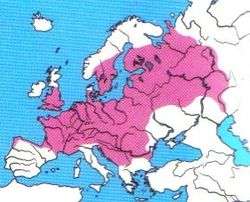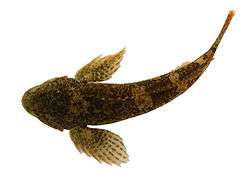European bullhead
| Bullhead | |
|---|---|
_(6102597595).jpg) | |
| Scientific classification | |
| Kingdom: | Animalia |
| Phylum: | Chordata |
| Class: | Actinopterygii |
| Order: | Scorpaeniformes |
| Suborder: | Cottoidei |
| Superfamily: | Cottoidea |
| Family: | Cottidae |
| Genus: | Cottus |
| Species: | C. gobio |
| Binomial name | |
| Cottus gobio Linnaeus, 1758 | |
The bullhead[1][2][3] (Cottus gobio) is a freshwater fish that is widely distributed in Europe, mainly in rivers. It is a member of the Cottidae family, a type of sculpin. It is also known as the miller's thumb, freshwater sculpin, common bullhead and European bullhead.[2][3]
The bullhead is a small demersal fish that lives both in cold, clear, fast-flowing small streams and in middle-sized rivers. It also occurs on gravelly shores of cold lakes. Further, it thrives in diluted brackish water of the Northern Baltic Sea.[2]
Description
The bullhead has a large broad head and tapering body, large fins and a rounded tail. The eyes are located near the top of the head. To the distinction from the other freshwater sculpin species found in Northern Europe, it can be told from the alpine bullhead Cottus poecilopus by the fact that the rays of its pelvic fins are of similar lengths while the first and last rays are longer in the alpine bullhead. It can be distinguished from the fourhorn sculpin by the fact that the dorsal and anal fins terminate close to the tail giving a short caudal peduncle. When it rests on the bottom, the pectoral fins flare out resembling wings. The bullhead is usually about 6 to 8 cm (2.4 to 3.1 in) long and is light brown mottled with darker colour. The pelvic fins are colourless and lack the stripes of the alpine bullhead.[4]
Biology
Food items eaten by the bullhead include benthic insects, crustaceans and other invertebrates.[2] It breeds in the spring. The male digs a shallow hollow in which batches of eggs are deposited by several females. He then guards the nest for the month or so that it takes for the eggs to hatch.[4]
Systematics and distribution

.jpg)
The European bullhead, as treated above, is widespread over most of the subcontinent and in England, but absent from the southern peninsulae and from Northern Scandinavia. It is not a single uniform taxon, however, but composed of morphologically and genetically differentiated subunits. Some of those have been distinguished already long time ago as separate subspecies or species with their own names, while in practice they have still mostly been treated under the concept of Cottus gobio. In 2005, Freyhof et al. suggested subdivision of the European Cottus gobio into fourteen distinct species, of which six had been described earlier and eight were newly described and named.[5]
- Cottus aturi - France (Adour)
- Cottus duranii - France (upper Dordogne, Loire etc.)
- Cottus gobio sensu stricto - Germany, Sweden, Central Europe
- Cottus haemusi - Bulgaria (Beli Vit of Danube basin)
- Cottus hispaniolensis - France, Spain (Garonne)
- Cottus koshewnikowi[6] - Northeast Europe
- Cottus metae - Danube drainage (Sava)
- Cottus microstomus[7] - East Central Europe: Poland, Slovakia, Ukraine etc.
- Cottus perifretum - Great Britain, Netherlands, Germany, France
- Cottus petiti - France (Lez River)
- Cottus rhenanus - Netherlands, Germany
- Cottus rondeleti - France (Hérault)
- Cottus scaturigo - Italy (Trieste, local)
- Cottus transsilvaniae - Romania (Argeș of Danube basin)
For instance, in this classification the British bullhead are Cottus perifretum.[8] In common usage and by e.g. conservation authorities, they are still mostly treated as Cottus gobio.[9][10][11][12]
References
- ↑ Cottus gobio IUCN Red List 2009
- 1 2 3 4 Froese, Rainer and Pauly, Daniel, eds. (2005). "Cottus gobio" in FishBase. 10 2005 version.
- 1 2 "Cottus gobio". Integrated Taxonomic Information System. Retrieved 24 January 2006.
- 1 2 "Bullhead: Cottus gobio". NatureGate. Retrieved 2013-12-17.
- ↑ Jörg Freyhof, Maurice Kottelat, Arne Nolte (2005) Taxonomic diversity of European Cottus with description of eight new species (Teleostei: Cottidae) Ichthyol. Explor. Freshwaters 16, 107-172.
- ↑ Cottus koshewnikowi IUCN Red List (2016)
- ↑ Cottus microstomus FishBase (2016)
- ↑ Freyhof, J. & Kottelat, M. (2008)Cottus perifretum The IUCN Red List of Threatened Species 2015-4.
- ↑ Bullhead Cottus gobio NBN Nature Spot
- ↑ Tomlinson ML & Perrow MR (2003). Ecology of the Bullhead Cottus gobio. Conserving Natura 2000 Rivers Ecology Series No. 4. English Nature, Peterborough.
- ↑ 1163 Bullhead Cottus gobio - SAC selection species account JNCC Joint Nature Conservation Committee [read March 2016]
- ↑ Bullhead Cottus gobio The Wildlife Trusts [read March 2016]

